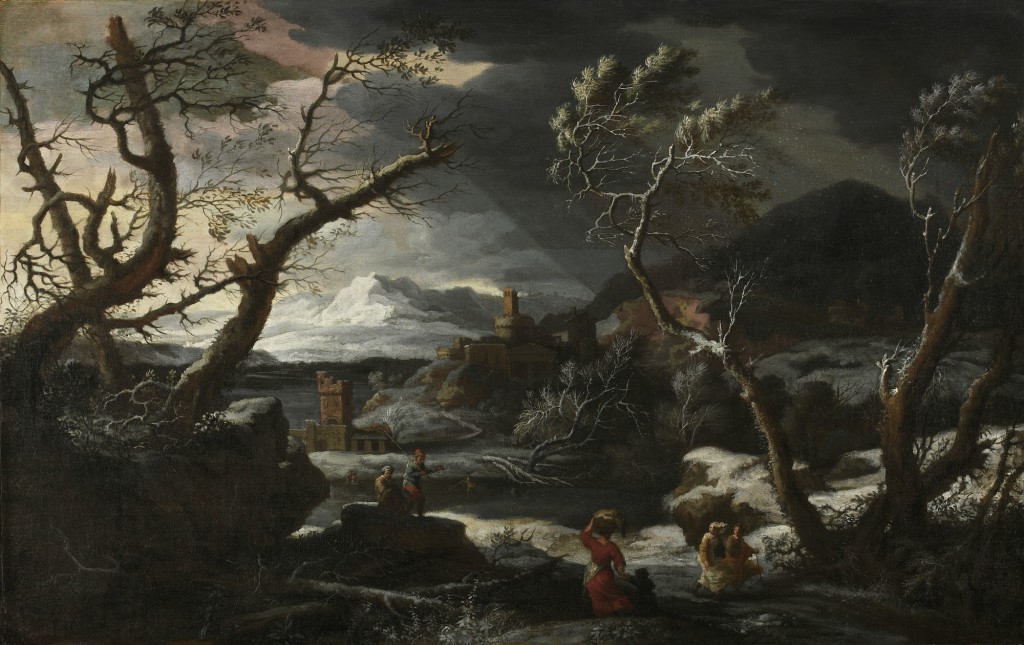Marco Ricci
(Belluno 1676 - 1729 Venice)
Winter Landscape, c.1725
Oil on canvas, 68.3 x 107.8 cm
Provenance:
Private collection, Munich
Exhibited:
Wintermärchen: Winter-Darstellungen in der europäischen Kunst von Bruegel bis Beuys, exhib. cat., Vienna, Kunsthistorisches Museum and Zurich, Kunsthaus Zürich, Cologne 2011, pp.262-3, no. 98 (repr.)
Marco Ricci is one of the foremost exponents of landscape painting in eighteenth-century Venetia. He trained under his uncle, Sebastiano Ricci (1659-1734), and began to work with him in his studio in Venice. After involvement in a murder, he was forced to leave for Split fearing criminal charges. However his uncle was able to intervene and no charges were pressed, so he was able to return. He later travelled to Florence and Milan where he came into contact with, and was influenced by, the painter Alessandro Magnasco. He resumed his partnership with his uncle, supplying landscape backgrounds for Sebastiano's figures. In turn, Sebastiano supplied the figures for Marco's landscapes. Both Riccis accepted commissions to work in London in the years 1708 to 1716. Marco also worked as a scene painter designing stage sets. Returning from London, he broke his journey in the Netherlands to familiarize himself with contemporary artistic developments. Records show that he was in Turin in 1724, later returning to live in his uncle's house in Venice to share his studio and to renew the partnership.[1]
The present landscape is not immediately recognizable as a work by Marco Ricci, even though the theme occurs elsewhere in his oeuvre. Winter landscapes are rare in Italian painting but they are not unknown. Francesco Guardi, Domenico Tiepolo and Giuseppe Bison all produced winter landscapes and Francesco Foschi was a leading exponent of the genre.
Clearly dateable to Ricci's later years, this painting represents the sum of multiple artistic influences experienced on his extensive travels, particularly on his visit to the Netherlands. He would also almost certainly have had access to the work of Flemish and Dutch artists in Venice.[2]
In conception and approach, the painting is reminiscent of the heroic landscapes of Pieter Mulier the Younger, known as the Cavaliere Tempesta. The dramatic juxtaposition of light and shade recalls the work of Salvator Rosa and the style of brushwork owes much to the emphatic ductus of Magnasco. The dramatic, wind-driven foliage bears comparison with the landscapes of Alexander Keirinx and the skaters in the middle ground have something of the meticulous figures of Hendrick Avercamp. Similar storm-laden skies are found in the work of Jacob van Ruisdael.
From a slightly elevated viewpoint the eye is led over a partly snow-covered country road towards a frozen river. A group of leafless, snow-swept trees acts as a repoussoir at either side of the image. Watchtowers and farmsteads line the river bank, their architecture characteristic of Venetia. In the middle ground are the ruins of a castle set on a rocky outcrop with a snow-covered mountain range in the background. Shown in the foreground is the retreating figure of a woman leading a child. The distinctive red of her clothing is a feature common to many of Ricci's paintings. Like the figures striding towards her, she is intent on fleeing the impending storm. The children playing on the ice are oblivious to its dangers.
Ricci's precise depiction of nature does little to soften the drama of the scene which somehow verges on the unreal. He is not alone in his ability to produce such hyperbolic qualities - they appear in the work of other early eighteenth-century Venetian painters.
Both compositionally and in terms of atmospheric quality the present winter landscape bears close comparison with another winter landscape by Ricci now in the Royal Collection at Windsor Castle.[3]
[1] For biographical details, see Annalisa Scarpa Sonino, Marco Ricci, Milan 1991.
[2] See Bernard Aikema and Bram de Klerck, ‘Marco Ricci e l'arte olandese del Seicento', in Dario Succi and Annalia Delneri (eds.), Marco Ricci e il paesaggio veneto del Settecento, exhib. cat., Belluno, Palazzo della Crepadona, Milan 1993, pp.73-4.
[3] Winter Landscape, c.1720, tempera on leather, 31.7 x 46.3 cm, Windsor Castle, Royal Collection Trust.

